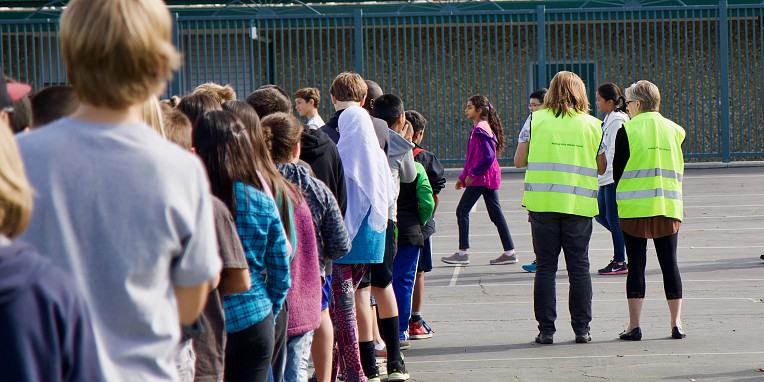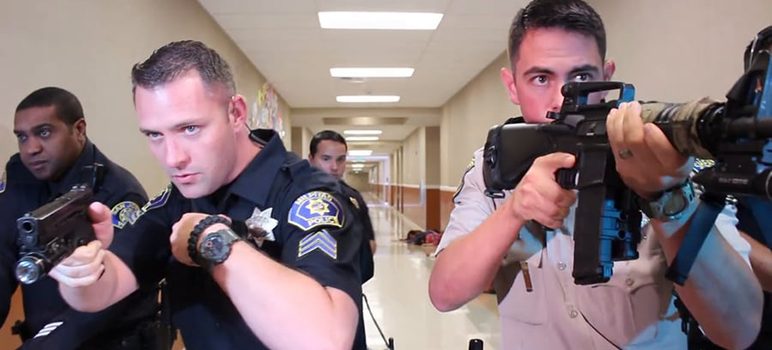Run, hide, fight. That’s the widely accepted mantra for how to react in the face of a mass shooter. If you can get out, get out. If you can’t, lie low. If all else fails, attack.
And though it’s a final resort, John Diaz says that third step can save lives.
“Ultimately, this is your last option,” the Emergency Preparedness Group Inc. consultant tells a room of educators and parents at a January workshop hosted by the Santa Clara County Office of Education (SCCOE). “It is an option, though.”
Diaz, a 22-year law enforcement veteran, motions toward a PowerPoint slide that describes what to do if an armed intruder enters a classroom: shout, use improvised weapons and, if possible, tackle the shooter to the ground.
“How are you gonna do that?” he asks the few-dozen folks in the audience. “Grab, use weapons, fire extinguishers, chairs. I’ll—like I said—I’ll grab that frame off the wall, and you hit somebody on the head with that, I guarantee you it’s going to hurt. Trash cans, whatever you can do. It’s that survival mindset.”
Use anything within reach, he says.
“Pens, pencils,” Diaz continues. “Can a pen or a pencil penetrate skin? Absolutely.”
Suggesting that children go toe-to-toe with an armed gunman may seem unrealistic. But in the five years since the Sandy Hook shooter killed 26 people on campus, the idea of telling kids to respond aggressively to an attack has gained renewed attention.
Critics say it presents liability risks for schools and students. Health professionals also worry that just talking about violence can harm children.
To make the tactic sound less forceful, however, the SCCOE and the county’s 31 school districts tweak the language a bit. Instead of referring to a “gunman” or “shooter” in lockdown drills, faculty say “intruder,” which is a little less scary for younger kids. And instead of a call to fight, it’s “run, hide, defend.”
“Defend yourself as you want to survive,” Diaz says before flicking through to a new slide, this one emblazoned with the phrase “fight for your life” in bold red letters.
It’s a grim reminder that mass shootings—or, for most of us, merely anticipating them—have become a fact of life. Just as schools during the Cold War taught students how to “duck and cover” in the event of a nuclear attack, children today learn what to do when the bullets start flying.

Campbell Middle School students line up for an active shooter drill. (Photo via CUSD)
The Feb. 14 massacre in Parkland, Florida, where a 19-year-old gunman killed 14 students and three teachers at Marjory Stoneman High reignited the national debate about gun control. It also stoked anxiety among parents and educators, prompting them to take another look at their school safety plans.
“Since the Florida incident, I get at least two emails a day about someone having some safety seminar or safety plan or safety something,” Campbell Union School District Superintendent Shelly Viramontez says.
An an effort to assuage parents’ fears, Viramontez sent out a message with a link to the district’s safety protocol. “I wanted to make sure our parents were informed of the safety processes that we use,” she says. “But a situation like [Parkland] really causes them to want make sure that we are doing everything we can to keep their students safe.”
It didn’t help when Silicon Valley schools these past few weeks reported a rash of violent threats. On March 1, the San Jose Police Department responded to two separate incidents in Franklin McKinley and Alum Rock Union Elementary school districts involving 12-year-old girls who allegedly made death threats against their classmates. The next day, Milpitas police responded to reports of a student’s violent threat on Snapchat.
While the last incident turned out to be unfounded, the panic it provoked was very real. Parents pulled their kids out of class midday and school districts from Morgan Hill to San Jose and elsewhere in the Bay Area sent emails and texts to assure families that they had the situation under control.
San Jose Unified School District has also seen a surge in concerned queries.
“Some parents and community members have expressed an interest in expanded drills and trainings for staff and students, which we were already exploring prior to Parkland,” district spokesman Peter Allen says.
Districts are required by the education code to have school safety plans that are available to parents upon request, SCCOE Risk Management Specialist Paul Finucane explains. San Jose Unified has a contract with SJPD to patrol elementary schools and provide armed resource officers at middle and high schools. Others contract with private consultants to drum up safety plans tailored to individual school sites.
“[They] have their own plans in place,” he says, “and their own sites are going to be thinking about how to respond to an active shooter.”
Viramontez says she hired her husband, retired Santa Clara County firefighter Joe Viramontez, to help Campbell Union bolster its emergency strategy. In the past decade, his company, Ics4Schools, has created safety protocols for more than 200 campuses. He’s also beta testing a mobile app in his wife’s district that he hopes will cut the time it takes to reunite students with parents in a crisis.
Some safety measures are built into the design of campuses. San Jose Unified spent bond money on new doors that lock from the inside in case teachers need to keep out an armed intruder. Moreland also fortified its doors.
Horrific shootings—from the one at Columbine High in 1999 to the one a week averaged since 2013, according to the SCCOE—have forced American schools to adopt a culture of preparedness. That requires not only a continual reassessment of safety strategies, but also how to deal with the well-being of kids who grow up bracing for gun violence.
“We are constantly looking to improve safety and security while maintaining an open and welcoming environment for students, staff, families and our entire community,” Allen says. “Rather than take a reactionary approach, we use incidents like the one in Parkland as opportunities to review our protocols and determine if changes need to be made”
Emergency Preparedness CEO John Ortega says it’s important to remain ever vigilant.
“If you have an emergency plan that’s great,” he says, “but if you don't train and do drills to it, it’s just as good as the ink on the paper.”
Yet even with an institutional emergency plan in place, t’s unclear how well the drills and slogans serve school kids when they need it most‚—especially since the advice can be conflicting or misleading. In his workshop, Diaz gives mixed messages. Despite his disclaimer about flight being better than fight, he encourages bystander intervention.
“Most of all the active shooter events that have happened—and even including from Las Vegas to Sandy Hook and others—law enforcement aren’t the ones that actually stop it,” he says. “It’s the public. It’s you.”
That’s an overstatement, to say the least.
Armed civilians stopped just 3 percent of mass shootings and unarmed bystanders 13 percent from 2000 to 2013, per the FBI. More often than not, the incidents end of the shooter’s volition, whether by suicide or fleeing the scene.
Students say it’s unsettling to not know how to act in a crisis.
“Some teachers say we should attack the active shooter if we can and some just say to run in the opposite direction,” Lincoln High School student Hazel Stange says. “So it’s a little bit confusing.”
Others point out that even the best training if no match against an AR-15, the kind of weapon that’s often used in mass shootings.
“I’m not confident there’s an actual plan that everyone knows to follow,” Prospect High School student Novia Dattatria says.
Until legislators figure out a policy fix that curbs future massacres, students and teachers will have to prepare for the worst. Frustration over that fact was the driving force behind the walkouts that took place on March 14 in what turned out to be the largest student demonstration since the Vietnam War. And it’s what has thousands of local students planning to join March for Our Lives, yet another nationwide protest, this weekend.
“We need to talk about it because it is a reality that we’re currently facing,” Prospect High student Izaiah Tilton says, “and we need to be prepared for it.”


I guess if cops are going to cowardly hide outside behind barricades during these events they now expect grade schoolers and teens to endanger themselves by confronting armed intruders.
Maybe sounds bizarrely viable to a police force that fails to respond using force and simply lays low and avoids confrontation. What a pity!
> Use anything within reach, he says. “Pens, pencils,”
DUH?!
Or maybe stick a flower in the shooter’s gun barrel?
Questions:
1. What percent of school shootings occur in schools that are “gun free zones””
2. How many school shootings have occurred in schools that are not “gun free zones”?
3. How many shooting victims have there been in “gun free zones”? How about in “NOT gun free zones”?
4. If I put a sign in front of my house that says “My neighbor’s house is a gun free zone”, can my neighbor sue me? On what legal theory?
NTSB figures show that more teens will die driving while texting that ever get shot in a school.